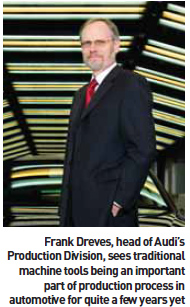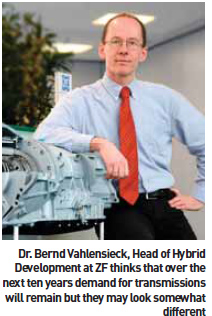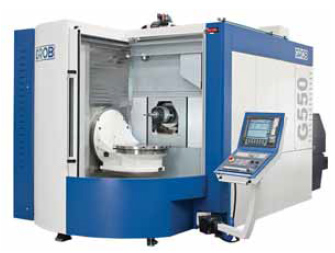The future, it would appear, belongs to the “electrifiers”. Audi, for example, is investing in the future-friendly technology of electric mobility: but before the first mass-produced electric Audi comes off the assembly line, a huge amount of IC-engined vehicles will be made. Nonetheless, Frank Dreves, head of the Production Division, emphasises that “electric cars are a major project for our corporate future.” Audi’s production supremo has his eyes firmly fixed on the automotive production process of the future: “If electric cars are to be incorporated in the production schedules in significant numbers, then of course we shall have to adapt our production process,” he says.
The disappearance of the mechanical drive train alters the requirement profile for the production engineering of the future – but this is not going to happen overnight. To quote Frank Dreves: “The transition from conventional automobiles to electric cars will be a gradual one. The traditional machine tool will accordingly remain an important constituent of the production process for quite a few years yet, and will have to be technologically designenhanced in the future as well.”
 Challenges and opportunities for component suppliers
Challenges and opportunities for component suppliers
Dr. Bernd Vahlensieck, Head of Hybrid Development at ZF Friedrichshafen AG: “the internal combustion engine will for the foreseeable future remain indispensable”. It will, he adds, increasingly be supplemented by electric drives. “We are accordingly confident that we shall continue to see new generations of transmissions.” There is a widely held misconception that hybrid vehicles are able to dispense with transmissions or auxiliary units: “Hybrid vehicles will continue to require highly efficient transmissions, only then can the technology’s true potential be harnessed.” There will indubitably be changes and technical paradigm shifts, meaning that new capabilities will have to be acquired. ZF is also channelling massive resources into this field: “This is why for many years now we’ve been doing very intensive work on the electrical elements in a vehicle, not just the drive train. At any rate, we do not believe that in ten years we shall have to close down our transmission factories. The transmissions will look somewhat different, but they are still going to exist.”
 Transfer the quality of present-day machine tools to new fields of application
Transfer the quality of present-day machine tools to new fields of application
In the long term, electrification of the drive train can be expected to have serious effects for the manufacturers of machine tools. At the Grob-Werke company in Mindelheim, they also believe that this trend will lead in future to increased diversification of drive systems.
“The most recent studies are predicting a share of up to 20% electric vehicles in total registrations by the year 2020”, is the message from Grob’s boardroom. This also means that only about 80% of the total volumes predicted will be fitted with “traditional” drives – with concomitant consequences for production figures in the category of traditional parts. So for the time being at least, it is premature to talk of entire categories of application for machine tools vanishing entirely. The fair stands will have many exciting new products on show; here are a few that we chose to highlight:
GROB Hall 16, Stand G36
When GROB introduced its G350 standard machine two years ago, some people in the industry expressed some surprise that “GROB, the automobile industry specialist” had  dared to challenge “the market share of the established standard machine manufacturers”. Any doubts expressed at the time have been dispelled. During the last two years and despite the toughest of environments in the machine engineering sector, the G350 has established itself in the market.
dared to challenge “the market share of the established standard machine manufacturers”. Any doubts expressed at the time have been dispelled. During the last two years and despite the toughest of environments in the machine engineering sector, the G350 has established itself in the market.
The showcasing of the G550 ‘big sister’ is the logical next step. The G550 can be used for machining the next level of work piece size. As well as the G550, the company will demonstrate the next stage in the development of the G350. New features this already successful standard machine include improved automation and reduction of setup times as a result of the new pallet changer and pallet store, a new circular swivel table with a diameter of 250mm and further options for the G350 including a special dust extraction unit, as is required for CRP machining.
www.grob.com
ISCAR Hall 9, Stands A21, B45 and D09
ISCAR will be showing, among many products, its new family of high speed milling (HSM) adjustable endmills and facemills for milling of aluminum, non-metallics, cast iron and hardened steel, especially in automotive and aerospace applications. The dynamically balanced cutters are specifically designed to work with polycrystalline diamond (PCD) or cubic boron nitride (CBN) inserts, protecting their edges and delivering outstanding surface finish. They also accommodate standard HSM-rated HELIMILL carbide inserts.
In both the endmills and facemills, internal coolant holes ensure a cooler cutting face while improving chip evacuation and resistance to built-up edge. Insert pockets in the cutters feature a flexible rear stopper, which can be adjusted by a slanted screw, enabling axial positioning of the cutting edge within 0.002mm.
www.iscar.de
 MAG Powertrain, MAG Europe Hall 16, Stand G34
MAG Powertrain, MAG Europe Hall 16, Stand G34
The MAG Hüller Hille brand name NBH has become well known for horizontal machining centers. Now this quality level of machine is available with a vertical main spindle. MAG will show the first model from the new NBV series, the NBV 400.
Apart from its small footprint, one of the machine’s main most striking characteristics is its modular design, which comprises the following main configurations:
• Fixed table for 3-axis machining, clamping surface 1000 x 700mm (X-, Y-axis)
• Tilting table (A-axis) for 4-axis machining
• Rotary/tilting table (C-on A-axis) for simultaneous 5-axis milling
• Rotary/tilting table (C-on A-axis) for 5-axis millturning, C-axis speed 1,000 rpm
This way, the NBV can be configured to provide machining solutions to multiple production requirements, be it in the die and mold, aerospace, medical, general machining or job shop sector. The standard disc-type tool magazine is designed to hold 40 tools. The NBV is available with Siemens or Bosch and soon also with Heidenhain controls.
www.mag-ias.com


































